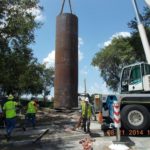- Company: Bradshaw Construction Corporation
- Industry: Water/Wastewater
- Location: Tampa, Florida
- Expected Completion Date: December 19, 2014
- Project Website
The CIAC Rivercrossing project was part of the Design Build Capital Improvements Program for the City of Tampa for future city growth. Bradshaw microtunneled a 60″ steel casing 426LF under the Hillsborough River for a new 36″ ductile iron pipe (DIP) water main. Two shafts were constructed: a 23ft ID launch shaft at Julian B. Lane River Park and a 10′ ID receiving shaft adjacent to The Stratz for the Performing Arts Center. The DIP water main was installed in the casing and shafts, tested, disinfected, and grouted in place. Project challenges included a compressed construction schedule, shafts in close proximity t the river (within 50ft), less than two pipe diameters of cover (8ft) over the tunnel under the river bottom, first time use of a wet soil mix for the launch shaft, numerous unknown existing utilities, tight line and grade tolerances (2-1/2″) with a short back sight (20′), and differing site conditions. In the end, the project was completed expeditiously without any accidents or safety violations. Bradshaw earned CH2M’s Excellence in Safety (ESP) award, which was the first project out of seventeen (17) to be presented the award.
What impact does this project have on America?
The City of Tampa and its residents and businesses have a great interest in the successful completion of the CIAC Rivercrossing project since it was an integral part of the continued efforts of the City of Tampa to improve the city’s existing infrastructure. Additionally, the project is a superb example of coordination and engineering excellence in practice. Coordination between all stakeholders was essential to project success and essential for addressing the stakeholders’ concerns. The project site was not only located along the Hillsborough River, but immediately adjacent to the Tampa Preparatory School, the Julian B. Lane River Park, and The Straz Center for the Performing Arts Center, which required continuous vigilance to avoid disruption of daily activities and environmental impact. Ultimately, through close coordination between the stakeholders there were zero disruptions to on-going schedules and events at the adjacent institutions and facilities, and zero environmental impacts caused by the CIAC Rivercrossing project. Other municipalities are interested in learning how collaboration between the Owner and constructor with other stakeholders can successful, in spite of difficult conditions.
What interesting obstacles or unusual circumstances did you overcome to complete the project?
Administratively, the day before mobilization, the shaft subcontractor declared bankruptcy. Within one month a new shaft design and means and methods for the launch shaft were selected and construction of the shaft started. From the technical perspective, both microtunneling shafts were located within 50ft of the Hillsborough River requiring sound engineering to address water infiltration concerns. The launch shaft was a wet-soil mix design (circular) that met the requirement prohibiting the use of vibratory methods to construct the launch shaft. Both shafts made maximum use of the limited worksite space available for execution and minimized impact to the adjacent institutions and facilities. The shaft size (20′ back sight) and short tunnel length created a challenge to meet the tight line and grade requirement. An 1/8″ error/offset equates to 2.66″, which is greater than the allowable 2.5″ tolerances. The line & grade tolerances were achieved with sound surveying practices.
What dangers and risks did you encounter, and describe any extraordinary methods used to keep workers safe?
The dangers (losing the seal at the entrance eye resulting in flooding, and failure of the shorting systems which would also result in flooding of the shafts) inherent to microtunneling where water is present existed on the CIAC Rivercrossing project. Bradshaw used proven engineering methods and designs for the two shafts (23′ ID x 38VF and 10′ ID x 40VF) constructed on site. Shaft design along with tried and tested entrance eye seal technology maintained a safe (and dry) work area for Bradshaw personnel and others who entered the shafts to support or inspect on-going work.
How did you leverage new technologies to work faster and reduce waste?
Bradshaw employed an innovative drilled, circular shaft (10′ ID x 40VF) at the receiving shaft site. The circular receiving shaft had a pre-installed, integrated exit eye that eliminated construction and installation of the exit eye after the shaft was constructed. The shaft was sufficiently large to allow retrieval of the microtunnel boring machince (MTBM) while minimizing the shaft footprint on the job-site adjacent to the Straz Center for the Performing Arts. The drilled, circular shaft reduced time equipment was on site and impact to the existing vegetation and river-side walk next to the job site.








